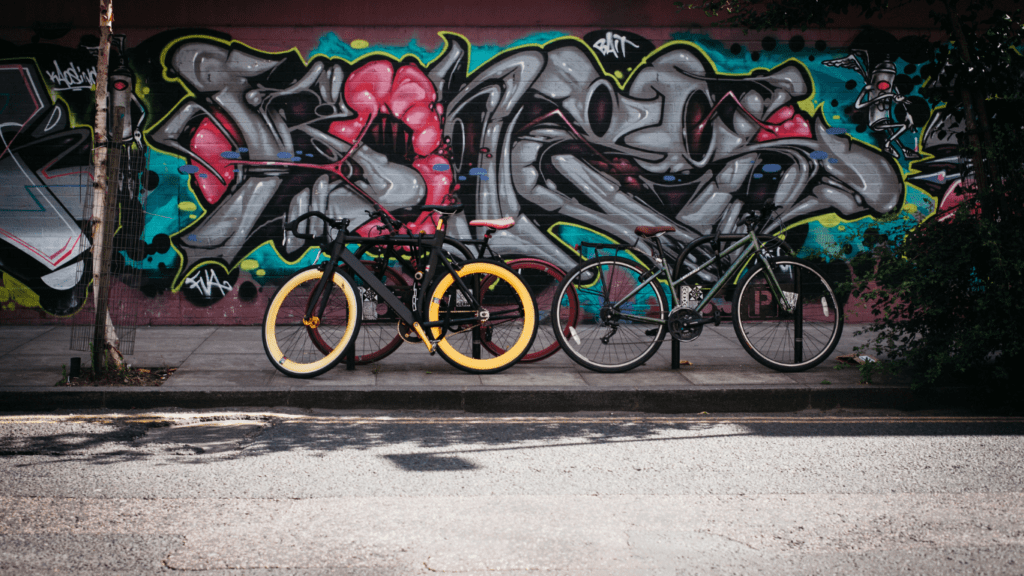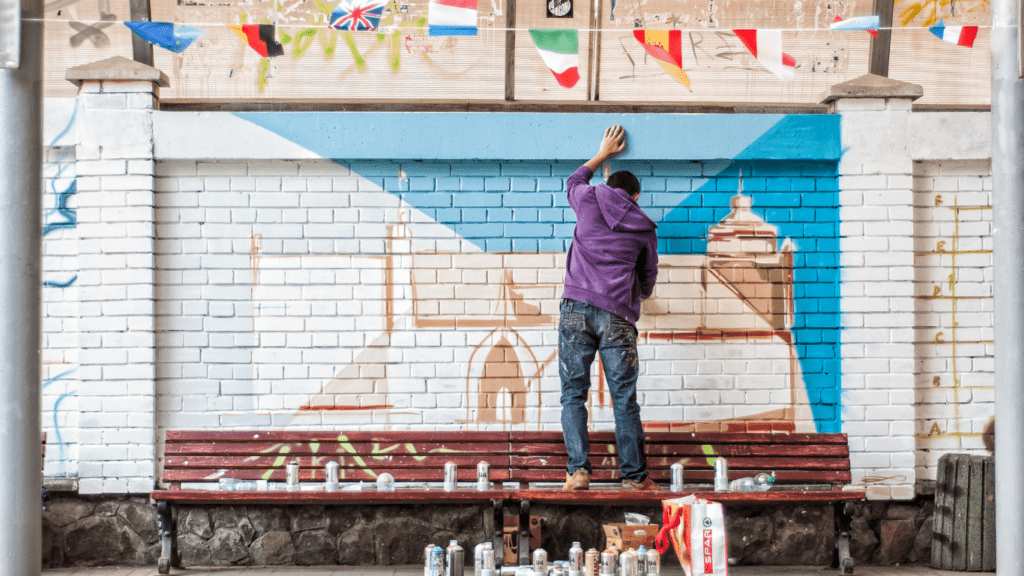The Evolution of Street Art
Street art has undergone a dramatic transformation, evolving from an illegal activity to a respected art form globally.
From Vandalism to Acceptance
Initially, society viewed street art as vandalism. Graffiti artists faced legal actions and steep fines for their work. However, the cultural landscape began to shift in the late 20th century.
With the rise of hip-hop culture in the 1980s, graffiti gained recognition as a legitimate form of expression. Major cities like New York and London played pivotal roles in this transition.
By the 1990s, street art started appearing in galleries. Artists like Jean-Michel Basquiat and Keith Haring bridged the gap between street and gallery art, showcasing the potential for graffiti as a respected medium. Public perception changed further, leading to the establishment of legal street art zones and organized mural projects.
Major Influences and Artists
Several influencers and artists have marked the evolution of street art.
- Banksy: Known for his anonymous identity and thought-provoking pieces, Banksy has achieved global fame. His work often tackles political and social issues.
- Shepard Fairey: Famous for the “Obey Giant” campaign and the Barack Obama “Hope” poster, Fairey has a significant impact on the street art scene.
- Jean-Michel Basquiat: Starting as a graffiti artist, Basquiat transitioned to become a celebrated contemporary artist. He maintained street art aesthetics in his gallery works.
- Keith Haring: His iconic pop-art influenced street art, making it accessible to a broader audience.
These artists have not only contributed to the evolution of street art but have also demonstrated that street art can convey powerful messages while earning recognition in the contemporary art world.
Characteristics and Styles of Street Art
Street art, with its diverse techniques and powerful messages, transforms public spaces into dynamic visual experiences.
Types of Street Art Techniques
Street art employs various techniques, each bringing unique textures and forms. Stencils, which artists like Banksy use, involve cutting designs into materials to spray paint through, creating repeatable patterns.
Wheatpasting uses adhesive to attach pre-made posters or artworks to surfaces, allowing for detailed and large-scale imagery. Stickers, often small and portable, make it easy for artists to disseminate their logos or messages quickly.
Murals, painted directly on walls, enable expansive, complex designs and often carry significant social commentary. Finally, reverse graffiti involves cleaning dirt from surfaces to create artwork, providing an eco-friendly alternative.
Iconic Murals and Their Messages
Iconic murals often occupy prominent urban spaces, delivering powerful statements. Diego Rivera’s “Detroit Industry Murals,” created in the 1930s, reflect industrial strength and workers’ struggles. Keith Haring’s “Crack is Wack” mural in New York City, painted in 1986, addresses drug addiction.
Shepard Fairey’s “Hope” poster, which evolved from street art to iconic imagery during the 2008 presidential campaign, signifies political change and hope. Furthermore, murals like the “East Side Gallery” in Berlin, painted on remnants of the Berlin Wall, showcase personal freedom and historical reflection. All these murals transcend aesthetics, offering insights into societal issues.
Street Art in Urban Cultural Development

Street art significantly influences urban cultural development. This influence extends beyond creative expression to impact neighborhoods and foster community engagement.
Impact on Neighborhoods and Real Estate
Street art can transform neighborhoods by attracting tourists, increasing foot traffic, and raising property values. Vibrant murals and artwork often turn once-overlooked areas into sought-after destinations.
For example, the Wynwood Walls in Miami have revitalized the Wynwood district, attracting businesses, tourists, and investors. Real estate developers sometimes commission street art to enhance property appeal, leading to gentrification but also economic growth.
Street Art Festivals and Community Engagement
Street art festivals play a critical role in community engagement. These events bring artists, residents, and visitors together, fostering a sense of community and cultural exchange.
Festivals like Upfest in Bristol and MURAL Festival in Montreal create platforms for emerging artists to showcase their work while engaging the local community in art appreciation. Workshops, talks, and interactive activities during these festivals educate attendees about the art form, promoting cultural appreciation and unity.
Legal and Ethical Considerations
Street art’s rise intersects with various legal and ethical issues, shaping its acceptance and regulation. These considerations impact both artists and the communities they engage with.
Copyright Issues and Artist Rights
Copyright protects an artist’s work, giving them exclusive rights to control its use. Street artists often face challenges in preserving these rights due to the ephemeral nature of their work.
Unauthorized reproduction and commercialization of their art without credit or compensation are common issues. For example, Banksy’s works are frequently replicated on merchandise without his consent. To protect their rights, some artists now document their work, ensuring proper attribution and potential legal recourse.
The Debate Over Public Space Usage
Public space usage for street art sparks debate between community enhancement and property defacement. On one hand, sanctioned murals transform urban landscapes, enriching local culture.
For instance, Berlin’s East Side Gallery repurposes a historical site into an open-air gallery. On the other hand, unsanctioned graffiti is viewed as vandalism, leading to legal penalties. Cities implementing designated graffiti zones, such as Hosier Lane in Melbourne, aim to balance artistic expression and property rights.
Street Art in Modern Galleries and Museums
Street art’s journey from streets to high-profile galleries showcases its growing acceptance in the art world.
Transition from Streets to Exhibition Spaces
Street artists initially faced significant opposition from authorities and the mainstream art scene. Over time, their bold expressions caught the attention of curators and art enthusiasts.
Exhibit spaces began to recognize the artistic value present in these raw, unfiltered forms. In the 2000s, major galleries and museums like the Tate Modern in London and the Museum of Contemporary Art in Los Angeles hosted street art exhibitions. These exhibits provide legitimacy and offer street artists new platforms to reach wider audiences.
Examples of Successful Street Artists in Galleries
Several street artists transitioned successfully to respected gallery artists:
- Banksy: Known for his provocative stencils, Banksy’s art has fetched millions in auctions while retaining its anti-establishment ethos.
- Jean-Michel Basquiat: Starting on New York streets, Basquiat became an iconic figure in modern art with works displayed in major galleries worldwide.
- Shepard Fairey: Creator of the iconic “Hope” poster for Barack Obama, Fairey bridges political activism and art in prominent galleries.
These artists exemplify the seamless transition of street art into esteemed exhibition spaces, gaining critical and commercial success while maintaining their distinctive voices.


 Harriet Bellvovy, the visionary founder of Innov Art Foundry, has cultivated a platform that seamlessly bridges the traditional and modern aspects of the art world. Under her leadership, Innov Art Foundry has become a hub for the latest art news, keeping enthusiasts and professionals alike informed about significant exhibitions, breakthroughs, and emerging trends. Her commitment to fostering a vibrant art community is evident in the platform's comprehensive coverage, ensuring that artists and art lovers are always at the forefront of the dynamic landscape.
In addition to art news, Harriet Bellvovy has expanded Innov Art Foundry's focus to include art entrepreneurship, providing valuable insights for artists aspiring to turn their creative passions into thriving businesses. Her dedication to exploring diverse forms of artistic expression is further showcased in the platform's deep dive into tattoo art and the transformative role of virtual reality in the art world. Harriet's innovative approach continues to inspire and empower a new generation of artists, making Innov Art Foundry a vital resource in the contemporary art scene.
Harriet Bellvovy, the visionary founder of Innov Art Foundry, has cultivated a platform that seamlessly bridges the traditional and modern aspects of the art world. Under her leadership, Innov Art Foundry has become a hub for the latest art news, keeping enthusiasts and professionals alike informed about significant exhibitions, breakthroughs, and emerging trends. Her commitment to fostering a vibrant art community is evident in the platform's comprehensive coverage, ensuring that artists and art lovers are always at the forefront of the dynamic landscape.
In addition to art news, Harriet Bellvovy has expanded Innov Art Foundry's focus to include art entrepreneurship, providing valuable insights for artists aspiring to turn their creative passions into thriving businesses. Her dedication to exploring diverse forms of artistic expression is further showcased in the platform's deep dive into tattoo art and the transformative role of virtual reality in the art world. Harriet's innovative approach continues to inspire and empower a new generation of artists, making Innov Art Foundry a vital resource in the contemporary art scene.